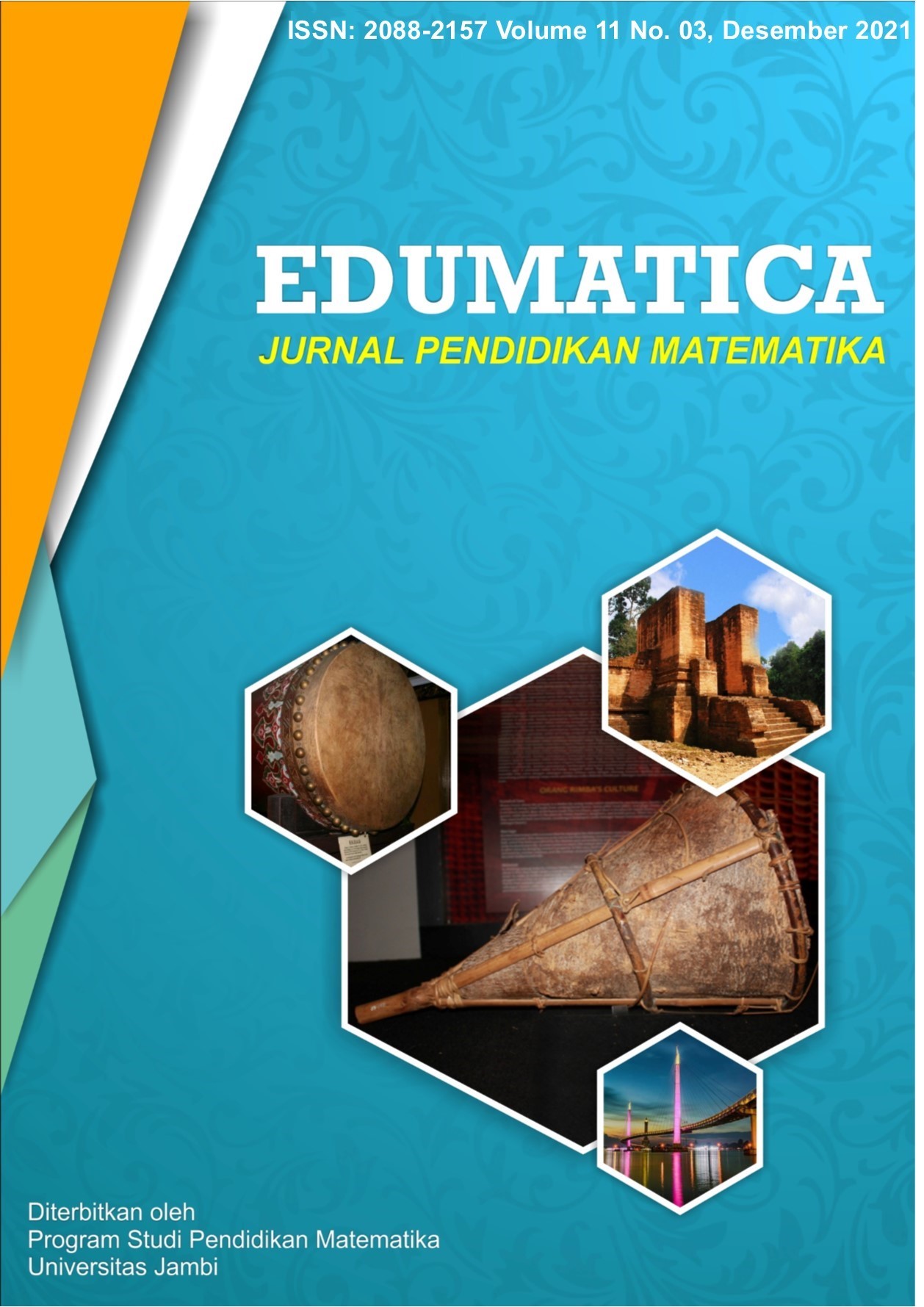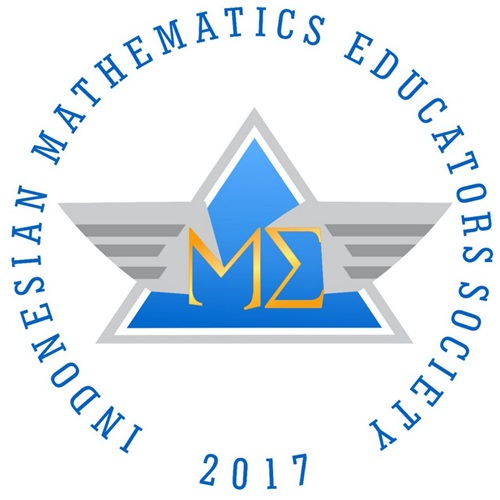High-Level Thinking and TPACK of Pre-Service Mathematics Teachers in the 21st Century Learning
DOI:
https://doi.org/10.22437/edumatica.v11i03.14338Keywords:
high-level thinking, mathematics learning, TPACKAbstract
In the 21st century, learning requires high-level thinking processes and mastery of technology. The benefits of using technology accompanied by high-level thinking include 1) having many alternative solutions to problems, 2) be a good co-worker, and 3) being more independent in finding solutions. Also, learning mathematics is one of the main lessons in class and has the main characteristics of structured learning and has a systematic flow. The attributes of existing mathematics learning may support the technology learning process, which also has an orderly system and algorithm. This study employed a cross-sectional survey-it exploring high-level thinking and TPACK in mathematics learning. The subject was 182 pre-service mathematics teachers in Universitas Muhammadiyah Purwokerto, Indonesia. This study showed high-level thinking, and TPACK indicated that the item was sufficient to perform factor analysis. The analysis results found that the Kaiser Meyer-Oikin (KMO) value for items in the high-level thinking construct questionnaire with 12 items showed 0.657 (l> 0.50). Subsequently, in TPACK construct questionnaire with 32 items showed 0.783. The results stated that higher-order thinking is the essential capital in learning mathematics. Therefore, learning mathematics also demands the dynamism of technological developments to support the success of learning mathematics.
Downloads
References
Aldama, C. De, & Pozo, J. I. (2017). How are ICT Used in the Classroom? A Study of Teachers’ Beliefs and Uses. Electronic Journal of Research in Education Psychology, 14(39). https://doi.org/10.25115/ejrep.39.15062
Anggoro, B. S., Kusumah, Y. S., Darhim, & Afgani, J. D. (2014). EnhancAnggoro, B. S., Kusumah, Y. S., Darhim, & Afgani, J. D. (2014). Enhancing Students Critical Thinking Ability In Mathematics By Through Improve Method. Mathematical Theory and Modeling, 4(5), 68-78.ing Students Critical Thinking Ability In Mathematic. Mathematical Theory and Modeling, 4(5), 68-78.
Arifa, F. N., & Prayitno, U. S. (2019). Peningkatan Kualitas Pendidikan: Program Pendidikan Profesi Guru Prajabatan dalam Pemenuhan Kebutuhan Guru Profesional di Indonesia. Aspirasi: Jurnal Masalah-Masalah Sosial, 10(1), 1-17. https://doi.org/10.46807/aspirasi.v10i1.1229
Bhattacharjee, B., & Deb, K. (2016). Role of ICT in 21 st Century’s Teacher Education. International Journal of Education and Information Studies, 6(1), 1-6.
Bingimlas, K. A. (2009). Barriers to the Successful Integration of ICT in Teaching and Learning Environments: A Review of the Literature. EURASIA Journal of Mathematics, Science and Technology Education, 5(3), 235-245. https://doi.org/10.12973/ejmste/75275
Borromeo, E., Elen, J., & Verschaffel, L. (2019). Relationships Between Mathematics Teachers’ Acceptance of Computer Supported-open Learning Environments and Their Beliefs: A Survey Study in Italian Lower Secondary Schools. Edulearn11: 3Rd International Conference on Education and New Learning Technologies, 3(July), 262-271.
Byrne, B. M. (2013). Structural Equation Modeling with Amos: Basic Concepts, Applications and Programming. In Journal of Applied Quantitative Methods (Vol. 5). Routledge. https://doi.org/10.4324/9780203805534
Campbell, P. F., Nishio, M., Smith, T. M., Clark, L. M., Conant, D. L., Rust, A. H., … Choi, Y. (2014). The Relationship Between Teachers’ Mathematical Content and Pedagogical Knowledge, Teachers’ Perceptions, and Student Achievement. Journal for Research in Mathematics Education, 45(4), 419-459. https://doi.org/10.5951/jresematheduc.45.4.0419
Cohen, L., Manion, L., & Morrison, K. (2017). Research Methods in Education. In Research Methods in Education. Eighth edition. | New York: Routledge, 2018.: Routledge. https://doi.org/10.4324/9781315456539
Connie, C. (2020). Teacher Perceived Impact of Technology on Elementary Classrooms and Teaching. Journal of Digital Learning in Teacher Education, 7(2), 147-173.
Creswell, J. W. (2014). Research Design: Qualitative, Quantitative, and Mixed Method. Thousand Oaks, CA: SAGE Publications, Inc. https://doi.org/10.1007/s13398-014-0173-7.2
DoÄŸan, M. (2012). Prospective Turkish Primary Teachers’ Views About the Use of Computers in Mathematics Education. Journal of Mathematics Teacher Education, 15(4), 329-341. https://doi.org/10.1007/s10857-012-9214-3
Drijvers, P. H. M., Monaghan, J., Thomas, M., & Trouche, L. (2017). Use of Technology in Secondary Mathematics. Journal for Research in Mathematics Education, 4(3), 14-23. https://doi.org/10.1142/9789814525725_0008
Eynde, P., & Corte, E. (2020). Students’ Higher Order Thinking and Achievement for Mathematics Learning. Journal of Advanced Research Design, 4(2), 23-37.
Farisi, M. I. (2016). Developing the 21st Century Social Studies Skills Through Technology Integration. Turkish Online Journal of Distance Education, 17(January), 16-30. https://doi.org/10.17718/tojde.47374
Fu, J. S. (2019). TPACK in Education: A Critical Literature Review and Its Implications. International Journal of Education and Development Using Information and Communication Technology, 9(1), 112. Retrieved from http://ijedict.dec.uwi.edu//viewarticle.php?id=1541
Hair, J. F., Black, W. C., Babin, B. J., & Anderson, R. E. (2014). Multivariate Data Analysis. In Pearson Education Limited.
Ibrahim, M. S., & Wekke, I. S. (2009). The Integration of ICT in the Teaching and Learning Processes : A Study on Smart School of Malaysia. 5th WSEAS/IASME International Conference on EDUCATIONAL TECHNOLOGIES (EDUTE’ 09), 5(2), 189-197. Retrieved from http://www.wseas.us/e-library/conferences/2009/lalaguna/EDUTE/EDUTE-28.pdf
Kaput, J. J., & Thompson, P. W. (1994). Technology in Mathematics Education Research: The First 25 Years in the JRME. Journal for Research in Mathematics Education, 25(6), 676. https://doi.org/10.2307/749579
Kelvin, J. (2020). Digital Technologies in the Classroom. Journal for Research in Math Education, 3(2), 11-23.
Koehler, M. J., Mishra, P., Kereluik, K., Shin, T. S., & Graham, C. R. (2014). Handbook of Research on Educational Communications and Technology. In J. M. Spector, M. D. Merrill, J. Elen, & M. J. Bishop (Eds.), Handbook of Research on Educational Communications and Technology. New York, NY: Springer New York. https://doi.org/10.1007/978-1-4614-3185-5
Lamichhane, B. R. (2018). TPACK about Mathematics and Instructional Practices. Journal for Research in Mathematics Education, VIII(February), 14-22.
Lisa, M. (2020). TPACK Level and Students Construction in Mathematics Learning during Covid-19 Pandemic Situation. Journal of Education and E-Learning, 4(3), 221-235.
Maesuri, D. (2018). Technological Pedagogical Content Knowledge (TPACK) pada Guru Matematika Sekolah Menengah di Manado. Jurnal Sains Dan Matematik, 31(2), 1-19.
Mapolelo, D. C., & Akinsola, M. K. (2015). Preparation of Mathematics Teachers: Lessons from Review of Literature on Teachers’ Knowledge, Beliefs, and Teacher Education. American Journal of Educational Research, 3(4), 505-513. https://doi.org/10.12691/education-3-4-18
Muhtadi, D., Wahyudin, Kartasasmita, B. G., & Prahmana, R. C. I. (2017). The Integration of Technology in Teaching Mathematics. Journal of Physics: Conference Series, 943(21), 012020. https://doi.org/10.1088/1742-6596/943/1/012020
Naismith, L., Lonsdale, P., Vavoula, G., & Sharples, M. (2016). Literature Review in Mobile Technologies and Learning. Journal of Educational Computing Research, 8(4), 31-44.
Patahuddin, S. M., Lowrie, T., & Dalgarno, B. (2016). Analysing Mathematics Teachers’ TPACK Through Observation of Practice. The Asia-Pacific Education Researcher, 25(5-6), 863-872. https://doi.org/10.1007/s40299-016-0305-2
Paul Chow, & Pepe, T. M. (2019). Teacher’s Attitudes Towards Technology in the Classroom. Journal for Research in Mathematics Education, 4(April), 21-38.
Piaw, C. Y. (2016). Mastering Research Methods (2nd ed.; S. Han, ed.). Malaya: McGraw-Hill Education.
Puspitarini, E. W., & Sunaryo, S. (2018). Pemodelan Technological Pedagogical Content Knowledge (TPACK) Berbasis Teknologi Informasi dan Komunikasi (TIK). Jurnal Ilmiah Program Studi Matematika STKIP Siliwangi Bandung, 3(2), 1-8.
Rahmadi, I. F. (2019). Technological Pedagogical Content Knowledge (TPACK): Kerangka Pengetahuan Guru Abad 21. Jurnal Pendidikan Kewarganegaraan, 6(1), 65. https://doi.org/10.32493/jpkn.v6i1.y2019.p65-74
Restiana, N. (2018). Evaluasi Profil TPACK untuk Guru Matematika Sekolah Menengah Pertama di Banten. Jurnal Penelitian Pendidikan, 35(2), 167-178. https://doi.org/10.15294/jpp.v35i2.14438
Richard, H. (2018). Managing Problem Solving Learning for Developing Students’ Creativity in Classroom. Journal of Education for Teaching, 3(14), 113-121.
Schlesinger, Z., & Wang, W. I. (2019). Higher Order Thinking Skills and the Evolution of Learning Technology in the 21 Century. Journal for Research in Mathematics Education, 4(3), 15-28. https://doi.org/10.1007/978-3-540-92784-6
Syah, R., Darmawan, D., & Purnawan, A. (2019). Analisis Faktor yang Mempengaruhi Kemampuan Literasi Digital. Jurnal Paedagogi, 10(2), 60-69.
Tabri, N., & Elliott, C. M. (2012). Principles and Practice of Structural Equation Modeling. Canadian Graduate Journal of Sociology and Criminology, 1(1), 59-60. https://doi.org/10.15353/cgjsc.v1i1.3787
Talib, N., Yassin, S. F. M., Nasir, M. K. M., & Bunyamin, M. A. H. (2016). Integrating Technological Pedagogical and Content Knowledge in Computer Programming Courses: Issues and Challenges. Journal of Advanced Research Design, 27(1), 1-15. Retrieved from http://www.akademiabaru.com/doc/ARDV27_N1_P1_13.pdf
Trisnawaty, W., Citrasukmawati, A., & Thohir, M. A. (2017). Self Assessment for Student Performance Based on Higher Order Thinking Skills in Physics Learning. Journal of Education and Learning (EduLearn), 11(4), 446-452. https://doi.org/10.11591/edulearn.v11i4.6456
Valtonen, T., Sointu, E., Kukkonen, J., Kontkanen, S., Lambert, M. C., & Mäkitalo-Siegl, K. (2017). TPACK Updated to Measure Pre-service Teachers’ Twenty-first Century Skills. Australasian Journal of Educational Technology, 33(3), 15-31. https://doi.org/10.14742/ajet.3518
van Borkulo, S. P., Kallia, M., Drijvers, P., Barendsen, E., & Tolboom, J. (2019). Computational Thinking and Mathematical Thinking: Digital Literacy in Mathematics Curricula. Proceedings of the 14th International Conference on Technology in Mathematics Teaching - ICTMT 14, 6(October), 384-386. Retrieved from https://s3.amazonaws.com/academia.edu.documents/56474455/PROPUES_TPM.pdf?response-content-disposition=inline%3B filename%3DDiseno_de_un_plan_de_Mantenimiento_Prod.pdf&X-Amz-Algorithm=AWS4-HMAC-SHA256&X-Amz-Credential=AKIAIWOWYYGZ2Y53UL3A%2F20200314%2Fus-e
Vinoth, N., & Nirmala, K. (2017). Deaf Students Higher Education System Using E-Learning. Journal of Education and Learning (EduLearn), 11(1), 41-46. https://doi.org/10.11591/edulearn.v11i1.5131
Wahyuni, F. T. (2019a). Hubungan antara Technological Pedagogical Content Knowledge (TPACK) dengan Technology Integration Self Efficacy (TISE) Guru Matematika. JURNAL PENDIDIKAN MATEMATIKA (KUDUS), 2(2), 141-152. https://doi.org/10.21043/jpm.v2i2.6358
Wahyuni, F. T. (2019b). Hubungan Antara Techonological Pedagogical Content Knowledge (TPACK) dengan Technology Integration Self Efficacy (TISE) Guru Matematika di Bengkulu. JURNAL PENDIDIKAN MATEMATIKA (KUDUS), 2(2), 21-32. https://doi.org/10.21043/jpm.v2i2.6358
Warner, S., & Kaur, A. (2017). The Perceptions of Teachers and Students on a 21st Century Mathematics Instructional Model. 12(2), 193-215.
Weippert, Achim and Kajewski, S. (2017). Internet-based Information and Communication Systems - a Case Study Analysis. Journal Basic of Education, 2(2), 103-116. https://doi.org/10.1016/S0261-5177(02)00005-5
Widodo, S. A., & Turmudi, T. (2017). Guardian Student Thinking Process in Resolving Issues Divergence. Journal of Education and Learning (EduLearn), 11(4), 432-438. https://doi.org/10.11591/edulearn.v11i4.5639
Yigit, M. (2014). A Review of the Literature: How Pre-service Mathematics Teachers Develop Their Technological, Pedagogical, and Content Knowledge. International Journal of Education in Mathematics, Science and Technology, 2(1), 26-35. https://doi.org/10.18404/ijemst.96390
Yoppi, W. P. (2017). Menjadi Guru Matematika: Antara Peluang dan Tantangan Teknologi untuk Masa Depan. Jurnal Ilmiah Pendidikan Matematika, 2(November), 1-8.
Yuli, S. (2017). Analisa Technological Pedagogical Content Knowledge (TPACK) Guru Matematika di Jawa Tengah. Jurnal Pendidikan Matematika PARADIKMA, 33(4), 11-23.
Downloads
Published
How to Cite
Issue
Section
License
Copyright (c) 2021 Wanda Nugroho Yanuarto, Anton Jaelani

This work is licensed under a Creative Commons Attribution-NonCommercial-ShareAlike 4.0 International License.






